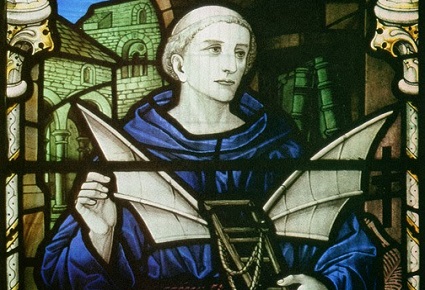Eilmer is not a saint, but he certainly deserves a place in the annals of obscure but important ecclesiastical personages of the Middle Ages. Eilmer was born in about 980 AD, and is best remembered for making a flight from the tower of Malmesbury Abbey in 1010 when he was a young monk there. The account of this exploit can be found in William of Malmesbury’s book Gesta Regum Anglorum.
William himself was born towards the end of the 11th century, so no doubt as a young man he heard the story from older monks. William describes how Eilmer fastened wings to his arms and his feet, and launched himself from the top of a tower, either a Saxon watchtower, or the old Abbey. The present Abbey was not built until nearly two centuries later, but it is likely that this tower would have been around the same height as the present structure. We do not know what material the wings were made of, but he had reportedly observed jackdaws in flight, and had worked out how to make use of the currents of air to glide, rather than just plummet to earth.
Eilmer’s flight is described in William’s entry for the year 1065:
“…a certain monk of our monastery, by name Elmer, bowing down with terror at the sight of the brilliant star, wisely exclaimed, “Thou art come! a matter of lamentation to many a mother art thou come; I have seen thee long since; but I now behold thee much more terrible, threatening to hurl destruction on this country.” He was a man of good learning for those times, of mature age, and in his early youth had hazarded an attempt of singular temerity. He had by some contrivance fastened wings to his hands and feet, in order that, looking upon the fable as true, he might fly like Dædalus, and collecting the air on the summit of a tower, had flown for more than the distance of a furlong; but, agitated by the violence of the wind and the current of air, as well as by the consciousness of his rash attempt, he fell and broke his legs, and was lame ever after. He used to relate as the cause of his failure, his forgetting to provide himself a tail.”1
He managed to cover a distance of around 200 meters. But it seems that it suddenly dawned on him what a risk he had taken, whereupon he panicked and came down with a bump, breaking both his legs. The strength of the wind also might have caused the sudden end to his adventure, but interestingly he also believed that he would have had more stability if he had provided himself with a tail. 2
Eilmer set about rectifying this shortcoming, and was making plans for a second flight when his abbot placed an embargo on any further attempts, and that was that. For more than half a century after these events, the limping Eilmer was a familiar sight around the community of Malmesbury, where he became a distinguished scholar.
William tells this story as an aside to a description of the appearance of the comet that was later known as Halley’s. Eilmer had the distinction of seeing it twice in his lifetime. He first saw it as a boy in 989, and the belief that it heralded doom was soon fulfilled when a wave of Danish attacks led to the destruction of many settlements, including the monastic establishment at Malmesbury. The second time was in 1066, and the event was swiftly followed by the Norman invasion of William the Conqueror.
There are several variations of his name. He is frequently referred to as “Elmer”, and also on occasions as “Oliver”. However the derivation of that name is probably a scribe’s copying error. The spelling taken on this occasion is that used by William of Malmesbury.
(1) William of Malmesbury, Gesta regum Anglorum, Chap. XIII, A.D. 1065, “Pope and Emperors.”
(2) Interestingly enough one Ibn Firnas, a Muslim scholar of the 9th century who made a similar flight, also attributed his disastrous landing to the lack of a tail.
Phillip Campbell, “Eilmer of Malmesbury,” Unam Sanctam Catholicam, September 15, 2016. Available online at: www.unamsanctamcatholicam.com/eilmer-of-malmesbury

